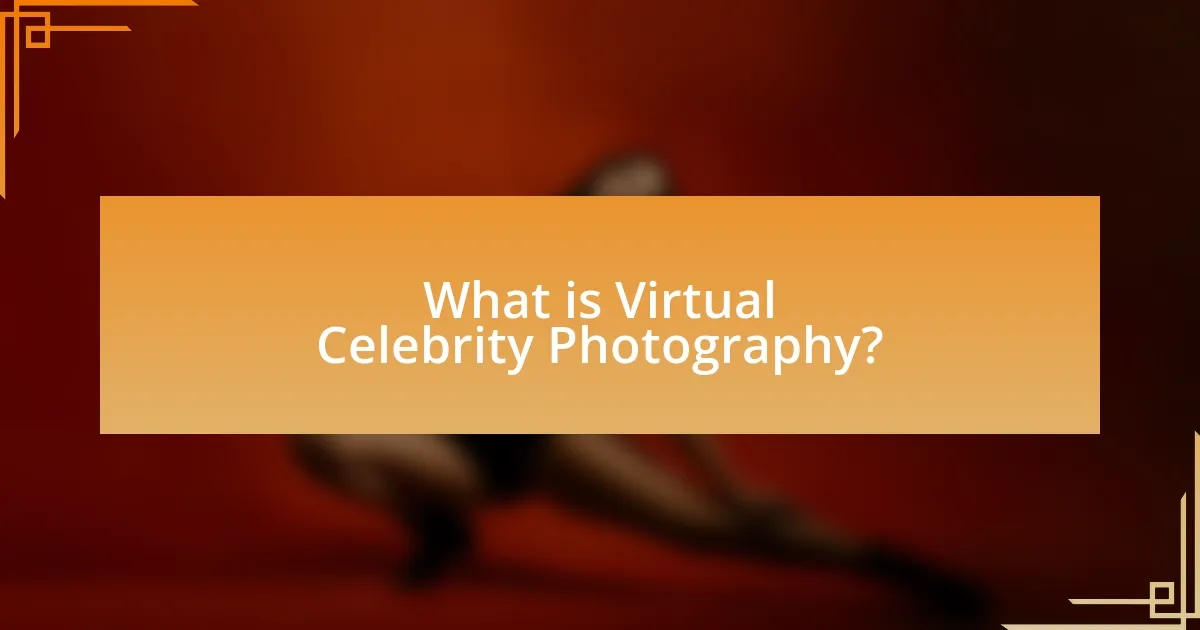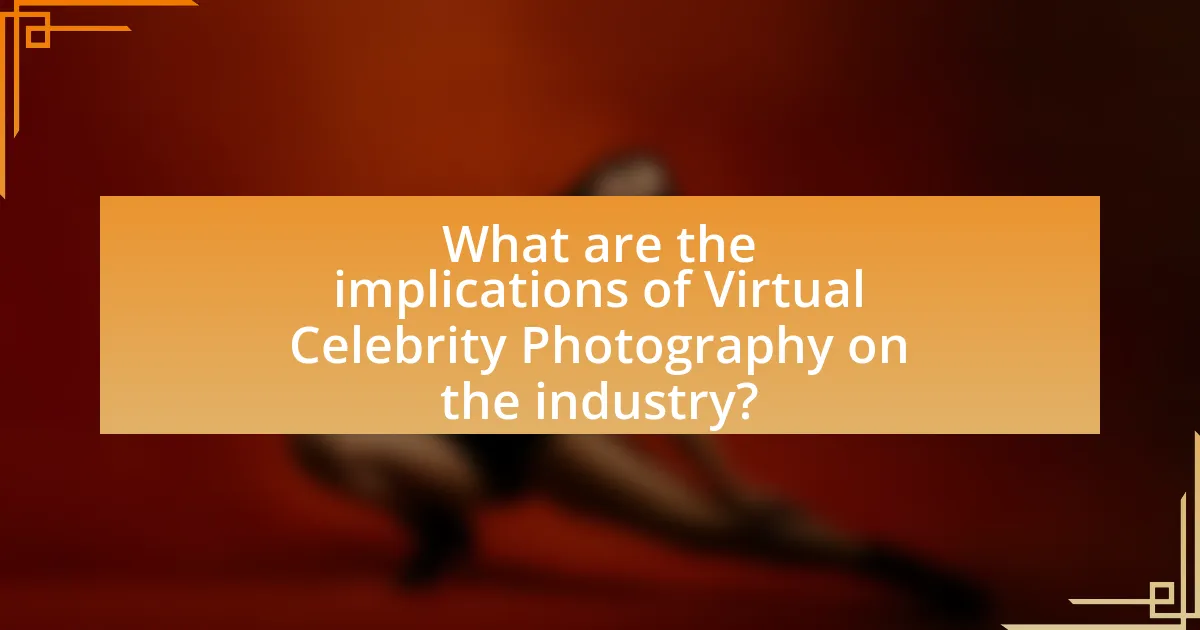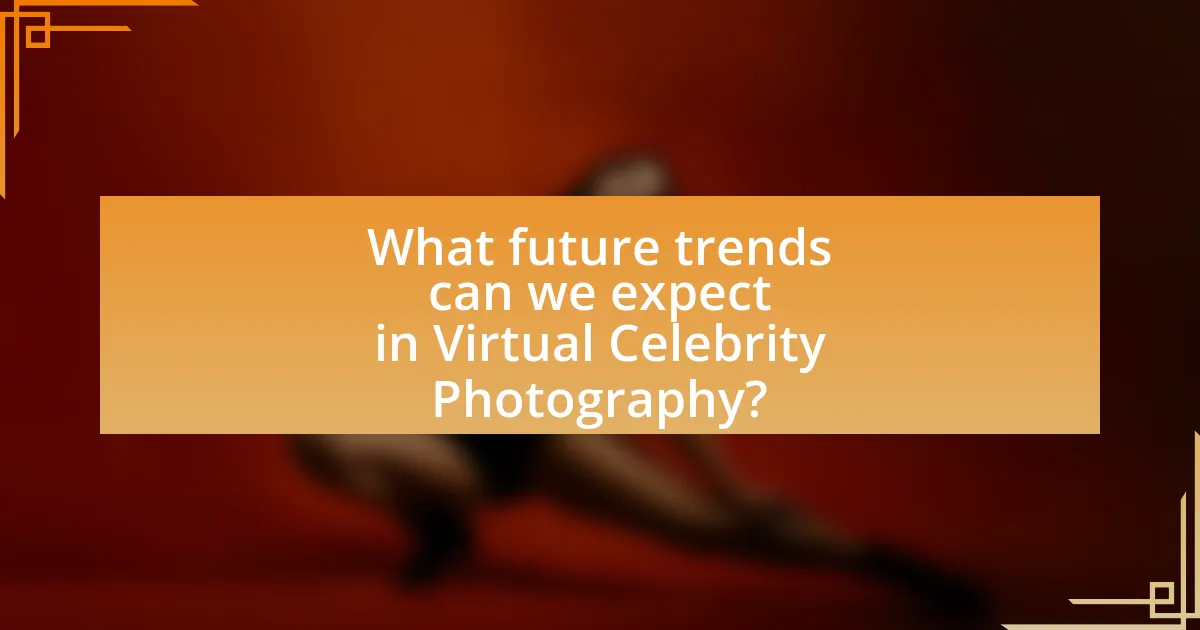Virtual Celebrity Photography is a digital art form that captures images of computer-generated characters resembling real-life celebrities, gaining traction due to technological advancements and the rise of social media. This article explores the evolution of this practice from traditional photography to a digital-first approach, highlighting the influence of artificial intelligence, augmented reality, and changing cultural norms on audience engagement. It examines the implications for the entertainment and advertising industries, the challenges faced in adapting to new technologies, and the ethical considerations surrounding authenticity and representation. Additionally, the article discusses future trends and best practices for photographers navigating this evolving landscape.

What is Virtual Celebrity Photography?
Virtual Celebrity Photography is a digital art form that involves creating and capturing images of virtual celebrities, which are computer-generated characters or avatars designed to resemble real-life celebrities. This practice has gained popularity due to advancements in technology, allowing for realistic representations and interactions in virtual environments. The rise of social media and digital platforms has further propelled this trend, as virtual celebrities can engage with audiences in ways traditional celebrities cannot, such as through interactive content and virtual events.
How has Virtual Celebrity Photography evolved over time?
Virtual Celebrity Photography has evolved significantly from traditional photography to a digital-first approach, driven by advancements in technology and changing consumer preferences. Initially, celebrity photography relied on physical cameras and in-person interactions, capturing moments at events or photoshoots. With the rise of social media and digital platforms, the focus shifted towards virtual representations, utilizing CGI and augmented reality to create lifelike images of celebrities without the need for physical presence.
This evolution is evidenced by the increasing use of virtual influencers, who are entirely computer-generated yet maintain substantial followings on platforms like Instagram. For instance, Lil Miquela, a virtual influencer, has garnered millions of followers and collaborations with major brands, showcasing the effectiveness of virtual celebrity photography in modern marketing. Additionally, the COVID-19 pandemic accelerated this trend, as physical events were restricted, prompting brands to adopt virtual photography to engage audiences.
Overall, the transition from traditional to virtual celebrity photography reflects broader societal shifts towards digital engagement and the integration of technology in visual storytelling.
What technological advancements have influenced its rise?
The rise of virtual celebrity photography has been significantly influenced by advancements in artificial intelligence, augmented reality, and high-speed internet connectivity. Artificial intelligence enables the creation of realistic virtual avatars and enhances image processing, allowing for more engaging and lifelike representations of celebrities. Augmented reality technologies facilitate interactive experiences, enabling fans to engage with virtual representations of their favorite celebrities in real-time. High-speed internet connectivity supports the seamless sharing and streaming of high-quality images and videos, making virtual celebrity photography accessible to a broader audience. These technological advancements collectively contribute to the growing popularity and evolution of virtual celebrity photography in contemporary media.
How do cultural shifts impact the perception of virtual celebrity photography?
Cultural shifts significantly influence the perception of virtual celebrity photography by altering societal values and expectations regarding authenticity and representation. As audiences increasingly prioritize diversity and relatability, virtual celebrity photography is often scrutinized for its ability to reflect these values. For instance, the rise of social media platforms has led to a demand for more genuine and unfiltered portrayals of celebrities, pushing virtual photography to adapt by incorporating elements that resonate with contemporary cultural narratives, such as inclusivity and realism. This shift is evidenced by the growing popularity of virtual influencers who embody diverse identities and lifestyles, thereby reshaping audience engagement and acceptance of virtual celebrity imagery.
Why is Virtual Celebrity Photography gaining popularity?
Virtual Celebrity Photography is gaining popularity due to its ability to create immersive and engaging experiences for fans. This trend is driven by advancements in technology, such as augmented reality and artificial intelligence, which allow for realistic and interactive representations of celebrities. According to a report by Statista, the global augmented reality market is projected to reach $198 billion by 2025, indicating a growing consumer interest in virtual experiences. Additionally, the COVID-19 pandemic accelerated the shift towards digital interactions, making virtual celebrity photography a convenient alternative for fans who seek connection in a socially distanced world.
What role do social media platforms play in this trend?
Social media platforms are crucial in the rise of virtual celebrity photography by providing a space for instant sharing and engagement. These platforms enable celebrities to connect directly with their audience, allowing for real-time feedback and interaction, which enhances their visibility and influence. For instance, Instagram reported that 90% of users follow at least one business account, indicating the platform’s effectiveness in promoting virtual celebrity content. Additionally, the use of hashtags and trends on platforms like TikTok and Twitter amplifies the reach of virtual photography, making it a significant aspect of modern celebrity culture.
How do fans engage with virtual celebrities compared to traditional ones?
Fans engage with virtual celebrities primarily through interactive platforms and social media, which allow for real-time communication and personalized experiences. Unlike traditional celebrities, whose engagement is often limited to passive consumption of media, virtual celebrities enable fans to participate in live events, vote on content, and interact directly through comments and messages. This engagement is supported by the rise of technologies such as augmented reality and artificial intelligence, which create immersive experiences. For instance, a study by the University of Southern California found that 70% of fans reported feeling a stronger connection to virtual influencers due to their interactive nature, compared to 40% for traditional celebrities.
What are the key characteristics of Virtual Celebrity Photography?
Virtual Celebrity Photography is characterized by the use of digital technology to create and manipulate images of celebrities that do not exist in reality. This form of photography often employs advanced techniques such as CGI (computer-generated imagery) and AI (artificial intelligence) to produce hyper-realistic representations. These virtual celebrities can engage with audiences through social media platforms, blurring the lines between reality and digital creation. The rise of this phenomenon is supported by the increasing acceptance of virtual influencers, with brands leveraging their appeal for marketing purposes, as evidenced by the success of virtual influencers like Lil Miquela, who has over 3 million followers on Instagram.
How does it differ from traditional celebrity photography?
Virtual celebrity photography differs from traditional celebrity photography primarily in its reliance on digital platforms and virtual environments rather than physical locations. Traditional celebrity photography typically involves in-person shoots, red carpet events, and public appearances, capturing celebrities in real-world settings. In contrast, virtual celebrity photography utilizes digital avatars, CGI, and social media platforms, allowing for creative expression without the constraints of physical presence. This shift is evidenced by the rise of virtual influencers and digital models, such as Lil Miquela, who engage audiences online without ever existing in the physical world.
What techniques are commonly used in virtual celebrity photography?
Common techniques used in virtual celebrity photography include 3D modeling, augmented reality (AR), and digital compositing. 3D modeling allows for the creation of lifelike representations of celebrities, enabling them to be placed in various virtual environments. Augmented reality enhances the viewer’s experience by overlaying digital images onto the real world, making interactions more engaging. Digital compositing combines multiple images or elements into a single cohesive photograph, allowing for creative storytelling and visual effects. These techniques are increasingly utilized as the demand for virtual representations of celebrities grows in digital media and marketing.
How does Virtual Celebrity Photography adapt to new norms?
Virtual Celebrity Photography adapts to new norms by leveraging advanced technology and social media platforms to create engaging, interactive experiences for audiences. This adaptation includes the use of augmented reality (AR) and artificial intelligence (AI) to generate lifelike virtual personas that can participate in real-time events, enhancing viewer engagement. For instance, brands increasingly collaborate with virtual influencers, who can be programmed to align with current trends and consumer preferences, thus maintaining relevance in a rapidly changing digital landscape. Additionally, the rise of remote content creation tools allows virtual celebrities to produce high-quality imagery and videos from anywhere, further aligning with the growing demand for digital content in a post-pandemic world.
What challenges does the industry face in this adaptation?
The industry faces significant challenges in adapting to virtual celebrity photography, primarily due to technological limitations and evolving consumer expectations. Technological limitations include the need for advanced software and hardware to create realistic virtual images, which can be costly and require specialized skills. Additionally, evolving consumer expectations demand high-quality, authentic experiences that virtual photography may struggle to deliver, leading to potential dissatisfaction. Furthermore, the industry must navigate legal and ethical concerns regarding the use of virtual likenesses, which can complicate the adaptation process. These challenges highlight the complexities involved in transitioning to this new norm in photography.

What are the implications of Virtual Celebrity Photography on the industry?
Virtual Celebrity Photography significantly impacts the entertainment and advertising industries by reshaping how celebrities engage with audiences and how brands market products. This form of photography allows for the creation of hyper-realistic digital representations of celebrities, which can be used in various media without the constraints of physical presence. For instance, brands can leverage virtual celebrities in campaigns, reducing costs associated with traditional celebrity endorsements while reaching wider audiences through digital platforms. The rise of virtual influencers, such as Lil Miquela, demonstrates this trend, as she has garnered millions of followers and collaborated with major brands, illustrating the effectiveness of virtual personas in marketing strategies. Additionally, this shift raises ethical questions regarding authenticity and the nature of celebrity, as audiences may struggle to differentiate between real and virtual figures.
How does it affect traditional photography practices?
The rise of virtual celebrity photography significantly impacts traditional photography practices by shifting focus from physical settings to digital environments. Traditional photographers often rely on in-person interactions and tangible locations to capture images, whereas virtual photography allows for the creation of entirely digital personas and settings, reducing the need for physical presence. This transition is evidenced by the increasing popularity of platforms like Instagram and TikTok, where virtual influencers thrive without ever being photographed in real life, thus altering the demand for conventional photography services. As a result, traditional photographers must adapt by incorporating digital techniques and exploring new avenues for creativity to remain relevant in an evolving market.
What are the potential job impacts for photographers?
The potential job impacts for photographers include a shift towards digital platforms and virtual environments, which can lead to reduced demand for traditional photography services. As virtual celebrity photography gains popularity, photographers may need to adapt their skills to include digital editing and virtual content creation. This transition is evidenced by the increasing prevalence of virtual influencers and the demand for high-quality digital imagery in social media marketing, which has grown by 50% in recent years. Consequently, photographers who embrace these changes may find new opportunities, while those who do not may face job displacement.
How do brands leverage virtual celebrity photography for marketing?
Brands leverage virtual celebrity photography for marketing by creating visually appealing and relatable content that resonates with their target audience. This approach allows brands to utilize the popularity and influence of virtual celebrities, who often have large followings on social media platforms, to enhance brand visibility and engagement. For instance, a study by Influencer Marketing Hub in 2021 indicated that campaigns featuring virtual influencers can achieve engagement rates up to 11 times higher than traditional celebrity endorsements. By integrating virtual celebrity imagery into their marketing strategies, brands can effectively tap into the digital landscape, fostering a connection with consumers who are increasingly drawn to innovative and immersive experiences.
What ethical considerations arise from Virtual Celebrity Photography?
Virtual celebrity photography raises significant ethical considerations, primarily concerning consent, representation, and authenticity. Consent is crucial, as virtual celebrities may not have the same agency as real individuals, leading to potential exploitation or misrepresentation of their likenesses. Representation issues arise when virtual celebrities are designed to reflect specific demographics or ideals, which can perpetuate stereotypes or unrealistic standards. Furthermore, authenticity is questioned, as audiences may struggle to differentiate between real and virtual personas, impacting trust and the nature of celebrity culture. These ethical dilemmas highlight the need for clear guidelines and standards in the evolving landscape of virtual celebrity photography.
How does it challenge notions of authenticity and representation?
The rise of virtual celebrity photography challenges notions of authenticity and representation by blurring the lines between real and digitally constructed identities. This phenomenon allows for the creation of hyper-realistic images that can manipulate perceptions of celebrity personas, leading audiences to question the validity of what they see. For instance, the use of advanced CGI and AI technologies enables the production of virtual celebrities who do not exist in reality, yet are marketed as authentic figures. This shift has significant implications for how society understands representation, as it raises concerns about the authenticity of experiences and the potential for misleading portrayals in media.
What are the privacy concerns associated with virtual celebrities?
Privacy concerns associated with virtual celebrities include data security, identity theft, and the potential for misuse of personal information. Virtual celebrities often rely on extensive data collection for their creation and interaction with audiences, which raises the risk of unauthorized access to sensitive information. For instance, a study by the Electronic Frontier Foundation highlights that the algorithms used to generate and maintain virtual personas can inadvertently expose personal data, leading to privacy breaches. Additionally, the lack of clear regulations governing the digital identities of virtual celebrities can result in exploitation, as their likenesses can be manipulated without consent, further complicating privacy issues.

What future trends can we expect in Virtual Celebrity Photography?
Future trends in Virtual Celebrity Photography will likely include increased use of artificial intelligence for hyper-realistic image generation, augmented reality integration for interactive experiences, and a shift towards personalized content tailored to individual fan preferences. The rise of AI technologies, such as generative adversarial networks (GANs), enables the creation of lifelike virtual celebrities, as evidenced by the success of digital influencers like Lil Miquela, who has garnered millions of followers. Additionally, platforms like Snapchat and Instagram are already incorporating augmented reality filters, suggesting that immersive experiences will become standard in virtual celebrity interactions. Finally, data analytics will drive content personalization, allowing virtual celebrities to engage with fans on a deeper level, reflecting trends in consumer behavior and preferences.
How might technology further shape this field?
Technology will further shape the field of virtual celebrity photography by enhancing the realism and interactivity of digital images. Advancements in artificial intelligence and machine learning enable the creation of hyper-realistic avatars and environments, allowing photographers to produce images that closely mimic real-life scenarios. For instance, tools like NVIDIA’s GANs (Generative Adversarial Networks) have demonstrated the ability to generate lifelike images, which can be utilized in virtual celebrity photography to create more engaging and immersive experiences for audiences. Additionally, augmented reality (AR) applications are increasingly being integrated into photography, allowing users to interact with virtual celebrities in real-time, thereby transforming how fans engage with their favorite personalities. This shift is supported by the growing popularity of platforms like Instagram and TikTok, where AR filters and effects are widely used, indicating a clear trend towards more interactive and technology-driven photography experiences.
What emerging technologies could enhance virtual celebrity experiences?
Emerging technologies that could enhance virtual celebrity experiences include augmented reality (AR), virtual reality (VR), artificial intelligence (AI), and blockchain. AR can create immersive environments where fans interact with celebrities in real-time, enhancing engagement. VR offers fully immersive experiences, allowing fans to attend virtual events or meet-and-greets, simulating physical presence. AI can personalize interactions by analyzing user preferences and providing tailored content, making experiences more relevant. Blockchain technology can ensure authenticity and ownership of digital collectibles, enhancing the value of virtual interactions. These technologies are already being integrated into platforms like Snapchat and Instagram, demonstrating their potential to transform how fans connect with celebrities.
How will audience expectations evolve in the coming years?
Audience expectations will evolve towards a demand for more authentic and interactive experiences in virtual celebrity photography. As technology advances, audiences increasingly seek genuine connections with virtual celebrities, desiring content that reflects real emotions and relatable narratives. Research indicates that 70% of consumers prefer brands that demonstrate authenticity, highlighting the importance of genuine engagement in shaping audience expectations. Furthermore, the rise of social media platforms has led to a preference for personalized content, with 80% of users indicating they are more likely to engage with brands that tailor their messaging to individual preferences. This shift will drive creators to innovate and adapt their approaches to meet the evolving desires of their audiences.
What best practices should photographers follow in this new landscape?
Photographers should prioritize authenticity and engagement in the new landscape of virtual celebrity photography. This involves creating genuine connections with their audience through relatable content and interactive experiences. Research indicates that audiences are more likely to engage with content that feels personal and authentic, as seen in studies by the Pew Research Center, which highlight the importance of relatability in social media interactions. Additionally, photographers should leverage technology, such as augmented reality and virtual reality, to enhance their storytelling and create immersive experiences. This approach aligns with industry trends showing a growing demand for innovative visual content that captivates viewers. By focusing on these best practices, photographers can effectively navigate the evolving landscape of virtual celebrity photography.



